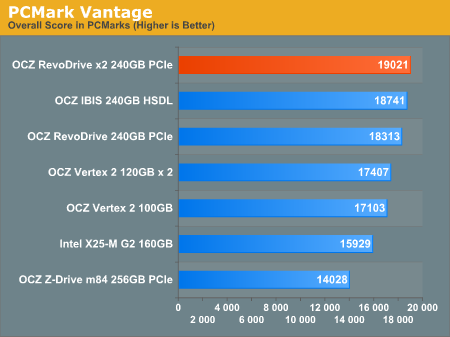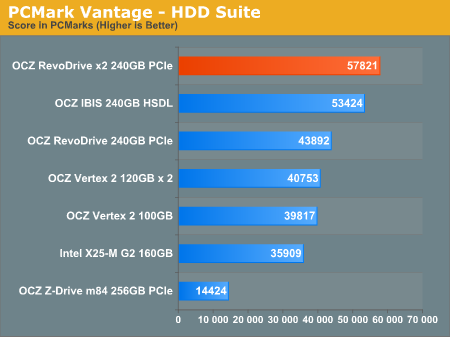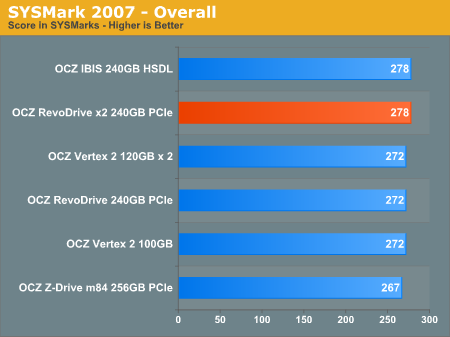A Quick Look at OCZ's RevoDrive x2: IBIS Performance without HSDL
by Anand Lal Shimpi on November 4, 2010 1:05 AM EST- Posted in
- Storage
- SSDs
- OCZ
- RevoDrive
- RevoDrive x2
The Test
Note our AnandTech Storage Bench doesn't always play well with RAIDed drives and thus we weren't able to run it on the RevoDrive x2.
| CPU | Intel Core i7 975 running at 3.33GHz (Turbo & EIST Disabled) |
| Motherboard: | Intel DX58SO (Intel X58) |
| Chipset: | Intel X58 + Marvell SATA 6Gbps PCIe |
| Chipset Drivers: | Intel 9.1.1.1015 + Intel IMSM 8.9 |
| Memory: | Qimonda DDR3-1333 4 x 1GB (7-7-7-20) |
| Video Card: | eVGA GeForce GTX 285 |
| Video Drivers: | NVIDIA ForceWare 190.38 64-bit |
| Desktop Resolution: | 1920 x 1200 |
| OS: | Windows 7 x64 |
PCMark Vantage & SYSMark 2007 Performance
With a four controller SF-1200 setup the real performance advantage won't be seen on most desktop workloads. The RevoDrive x2 is only a few percent faster overall than the original RevoDrive and about 10% faster than a single OCZ Vertex 2.

In the HDD suite the performance advantage is much greater. The RevoDrive x2 is also a bit quicker than the IBIS, perhaps because of the lack of overhead posed by the HSDL interface. There's a 31% performance improvement over the original RevoDrive.

SYSMark shows that most CPU bound desktop workloads won't be impacted by the RevoDrive x2. If your applications are IO bound, expect to see an impact but otherwise there's not much to gain here.











46 Comments
View All Comments
Out of Box Experience - Friday, November 5, 2010 - link
Give us some Real-World numbers for a worst case scenario!Running Windows XP-SP2 on one of these with XP partitions (Not Aligned) and ZERO SSD Tweeks, how fast can these drives copy and paste 1GB of data with over 1000 files in at least 100 directories
A vertex 2 can do it @ a meager 3.636MB / sec
A 2.5 inch 5400RPM WD Laptop drive is FASTER than a Vertex 2 in this type of test
A 7200RPM WD Desktop Drive is A LOT faster
SSD's are still CRAP at copying and pasting uncompressible data around on the sasme drive that its stored on
But they boot about as fast as my 300X Compact Flash
Thats something I guess
extide - Monday, November 8, 2010 - link
No, just the the drives optimally. Align it.That's like saying I am going to limit my HDD to PIO mode and bench it against another one in UDMA mode.
Pretty much assinine, I mean you can even fix an unaligned partition and move an unaligned one from an HDD to an SSD and make it aligned. It's not very hard...
thanared - Friday, November 5, 2010 - link
I don't know how Anand does his test... but I have 2 revo drive 240 gb in a stripe on an i7 based asus super computer and i get 1028 MBytes per second.I break the revo drive stripe, stripe in windows, and align the drive.
thanared - Friday, November 5, 2010 - link
Sorry.. using Iomter, 1 worker, 32 outstanding i/o per target, 128k sequentialFH123 - Saturday, November 6, 2010 - link
Anand, if you're investigating the real-world impact of the idle garbage collection bug, can you use a full-disk encryption product, such as Truecrypt? I believe even when you just initialise a TrueCrypt drive (the recommended slow version, not the quick), it fills every sector with random garbage for security purposes, which is presumably uncompressible. I suspect that, until such encryption products are written to interface with the TRIM command, they will cause you a real world problem right there and then, because they'll fill the disk with uncompressible data from the get-go. Remind us, do Sandforce implement full-drive encryption themselves, mitigating the need for programs like TrueCrypt when you want encryption?Something unrelated also springs to mind. You have previously slated Samsung SSDs for their relatively poor performance and - now I can't remember for sure, so correct me if I'm wrong - lack of TRIM. However I've read elsewhere that the later Samsung SSDs, e.g. since maybe a year ago or so, actually recognise when they are being formatted with an NTFS file system. This would theoretically allow them two things: (A) Automatically align the file system sector/cluster boundaries with SSD sectors and (B) Perform TRIM internally, because it understands NTFS and knows which sectors are empty. If true, then I think this is really quite smart. It avoids the need for TRIM altogether and should work across all Windows operating systems that use NTFS, even XP. The downside is, if Microsoft change NTFS in such a way as to break Samsung's understanding of it. That would, hypothetically, create an incompatibility with future Microsoft OSs.
x0rg - Tuesday, November 9, 2010 - link
What if you just create a partition that is not using the full drive capacity, but 95%? would it help?